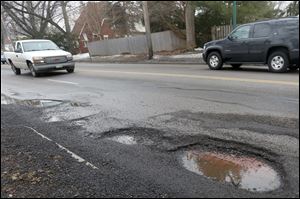
FEATURED EDITORIAL
Kicking debt down the road
1/24/2017Some of the money Mayor Paula Hicks-Hudson’s administration found to repave streets this year came from a debt-refinancing scheme that will leave the city with higher payments later. That puts an asterisk on the mayor’s election-year achievement.
Of the $4 million the mayor has said will be spent repairing residential streets, $500,000 comes from debt restructuring, debt commissioner Bryan J. Benner told The Blade editorial board. That’s part of $1.5 million the restructuring is saving the city in payments on its general-obligation debt this year. The savings, Finance Director George E. Sarantou said, would all go into the capital budget, which can only be spent on things that last at least five years, such as streets, buildings, and fire vehicles.
Click here to read more Blade editorials

Cars pass near splattered asphalt and a deep pothole in Toledo
The restructuring will save the city $1.1 million next year, too. But the total savings through 2023 is just $167,362. That’s because beginning in 2019, the city will be obligated to pay more on its existing debt than the old terms required. The biggest hits come after two mayoral elections: In 2022, the city’s obligation will be $1.2 million more than under the old commitments, and it’ll be almost $1 million more in 2023. Still, under the new plan as under the old, beginning in 2018, each year’s payments will be lower than the previous year’s.
Mr. Sarantou, Mr. Benner, and city spokesman Janet Schroeder confirmed that at least one reason the payments were structured this way was to provide savings now that could be spent now.
The restructuring makes the mayor look better than she deserves to look. She’s giving people what they want — street repair — and she’s giving it to them now. That’s certainly good. But to help make it happen, her administration has committed the city to higher payments in the next mayoral term and even higher ones the term after. Those payments will mean less money available for roads and everything else when that time comes.
Hasn’t Toledo had enough of these “buy now, pay later” schemes?
The plan is not entirely irresponsible. There is an overall savings. And at least for now, the money is being budgeted for projects of lasting value, some or all of which will be useful when we’re making the higher payments. Still, when Toledoans look at the street repaving and consider thanking the mayor in this election year, they should remember: There’ll be a price to pay five years down the road.